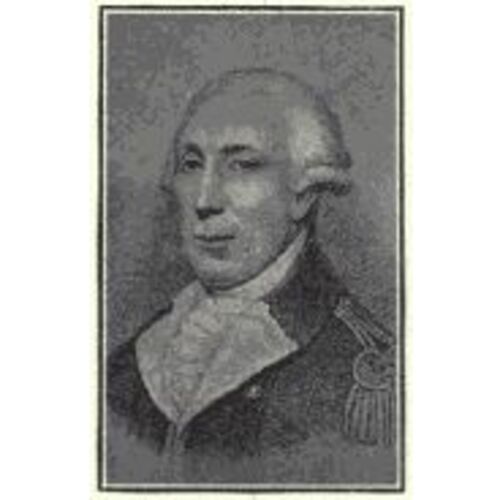
Source: Courtesy of Wikimedia Commons
MUNRO, JOHN, soldier, merchant, and officeholder; b. 1728 at Fyrish, parish of Alness (Highlands), Scotland, son of Hugh Munro; m. 5 April 1760 Mary Brower, in Schenectady, New York, and they had eight children; d. 27 Oct. 1800 at Dickinson’s Landing (probably Long Sault, Ont.).
John Munro, a soldier in the 48th Foot, came to America in 1756 and served in the Seven Years’ War, after which he was granted land as a disbanded soldier and settled in the province of New York. He became a merchant-trader in Albany and quickly prospered. He acquired land holdings of over 11,000 acres and about 1765 he moved to an estate near Bennington (Vt), where he farmed and operated mills, a pot and pearl ashery, and a nail factory. Munro was an elder of the “English Presbyterian Church” in Albany, and as a magistrate of Albany County he was actively involved in the dispute between New York and New Hampshire over the ownership and jurisdiction of the “Hampshire grants” (now Vermont).
Since Munro was a prominent Tory, his family and property were harassed in the pre-revolutionary period, and he was twice imprisoned by the rebel forces. From 1776 to 1784 he served under Sir John Johnson* as a captain in the 1st battalion King’s Royal Regiment of New York and among other services led a successful raid on Ballston (Ballston Spa, N.Y.) in October 1780 and commanded the garrison at Coteau-du-Lac (Que.) in 1781. In 1783, at Haldimand’s request, he undertook a tour of exploration from Quebec to Halifax via the Témiscouata route on behalf of a group of loyalists who had obtained land in Nova Scotia. Munro reported on the route and on the suitability of lands in Nova Scotia and present-day New Brunswick.
John Munro was placed on half pay in 1784 and settled that year with his company in what became the Luneburg District of Upper Canada. From 1784 to 1787 he was in England, supporting himself and his family in Canada on borrowed money while trying to get adequate compensation for the loss of his New York property, whose worth he estimated at more than £10,000. He eventually received less than £300 and returned to Canada disillusioned and nearly penniless. He was, however, rewarded in other ways. In 1788 he was made sheriff and a member of the land board of the Luneburg District. He built and operated grist- and sawmills on the St Lawrence River as early as 1791. Munro was one of a number of loyalist leaders who were granted townships for settlement in 1792 and 1793. Although these grants were later rescinded, Munro and his family were given large amounts of land in Matilda Township and elsewhere in the Eastern District. He was an original member of the Legislative Council of Upper Canada, appointed 12 July 1792, and in December of that year he became a justice of the district Court of Common Pleas. Munro also held a number of minor or temporary posts. He was a magistrate of the Eastern District; in 1794 he served as one of the commissioners who conferred with representatives from Lower Canada on the division of customs duties in an attempt to secure for Upper Canada a share of the revenue from goods destined for that province. In 1797 he served on the Heir and Devisee Commission, which was established to hear claims to loyalist grants which had passed out of the hands of the original grantees. Munro was a conscientious legislator and judge but his public career was notable mainly for unswerving loyalty to authority. In 1794 he had voted, at Lieutenant Governor Simcoe*’s request, for the abolition of the Court of Common Pleas, as part of Simcoe’s attempt to make the legal system of Upper Canada more like that of Great Britain.
Munro had acquired land and offices in Upper Canada, but he never regained the affluence he had enjoyed before the American revolution and he died in relatively modest circumstances.
BL, Add. mss 21779, 21826–29. DPL, Burton hist. coll., John Munro papers (copies at PAO). PAC, MG 24, A6; RG 1, L3, 150, 177, 327, 328, 331; RG 68, General index, 1651–1841. PRO, AO 12/21, 12/101, 13/56 (copies at PAC). [Patrick Campbell], Travels in the interior inhabited parts of North America in the years 1791 and 1792, ed. H. H. Langton and W. F. Ganong (Toronto, 1937). [François Daniel], Nos gloires nationales; ou, histoire des principales familles du Canada . . . (2v., Montréal, 1867), II, 48. [A.] E. Ryerson, The loyalists of America and their times: from 1620 to 1816 (2nd ed., 2v., Toronto, 1880), II, 261–64. Grant Carr-Harris, “Ancestry of Captain, the Honourable, John Munro (1728–1800),” Families (Toronto), 16 (1977), 71–84. E. A. Cruikshank, “The King’s Royal Regiment of New York,” OH, XXVII (1931), 193–323.
Cite This Article
J. K. Johnson, “MUNRO, JOHN,” in Dictionary of Canadian Biography, vol. 4, University of Toronto/Université Laval, 2003–, accessed December 30, 2025, https://www.biographi.ca/en/bio/munro_john_4E.html.
The citation above shows the format for footnotes and endnotes according to the Chicago manual of style (16th edition). Information to be used in other citation formats:
| Permalink: | https://www.biographi.ca/en/bio/munro_john_4E.html |
| Author of Article: | J. K. Johnson |
| Title of Article: | MUNRO, JOHN |
| Publication Name: | Dictionary of Canadian Biography, vol. 4 |
| Publisher: | University of Toronto/Université Laval |
| Year of publication: | 1979 |
| Year of revision: | 1979 |
| Access Date: | December 30, 2025 |



